
F-Zero X is a 1998 futuristic racing video game for the Nintendo 64 console, developed and published by Nintendo. It is a sequel to the original F-Zero (1990), and is the first F-Zero installment with 3D graphics. The game has a steep learning curve and its gameplay experience is similar to that of the original. An Expansion Kit, including a track and vehicle editor, was released in Japan in 2000.

Crash Team Racing is a 1999 kart racing video game developed by Naughty Dog and published by Sony Computer Entertainment for the PlayStation. It is the fourth installment in the Crash Bandicoot series. The game's story focuses on the efforts of Crash Bandicoot, Doctor Neo Cortex, and other ragtag team of characters in the Crash Bandicoot series, who must race against the egomaniacal Nitros Oxide to save the Earth from destruction. In the game, players can take control of one of fifteen Crash Bandicoot series characters, though only eight are available at first. During the races, offensive and speed boosting power-ups can be used to gain an advantage.

Gran Turismo 4 is a 2004 sim racing video game developed by Polyphony Digital and published by Sony Computer Entertainment for the PlayStation 2. It is the fourth main installment and the sixth overall in the Gran Turismo series. It was released on December 28, 2004, in Japan and Hong Kong, February 22, 2005, in North America, and March 9, 2005, in Europe, and has since been re-issued under Sony's Greatest Hits brand.

Star Wars Episode I: Racer is a 1999 racing video game based on the podracing sequence in the film Star Wars: Episode I – The Phantom Menace. The game features all of the racers and race course on Tatooine from The Phantom Menace. It adds several new courses, on Tatooine and various planets. It has several single player modes, including a tournament mode. The format of multiplayer mode varies by platform. Jake Lloyd and Lewis MacLeod, who portrayed Anakin Skywalker and Sebulba in The Phantom Menace, reprise their film roles in the game.

F1 Race is a racing video game developed by HAL Laboratory and published by Nintendo for the Famicom in 1984. A version was released in 1990 for the Game Boy in Japan and in 1991 in Europe and North America, including the Four Player Adapter for four-player gameplay.
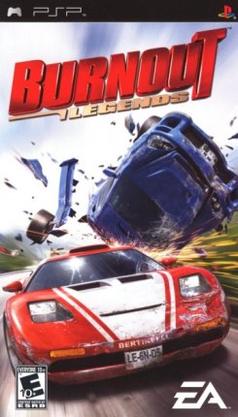
Burnout Legends is a racing video game developed by Criterion Games and published by Electronic Arts for PlayStation Portable. The game features many of the tracks and gameplay modes from the first three Burnout titles but repackaged for the handheld format. Many of the gameplay modes are similar to Burnout 3: Takedown using a mixture of old and new tracks. The Nintendo DS port was developed by Visual Impact.
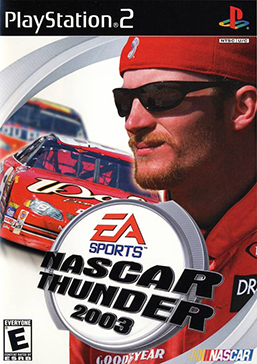
NASCAR Thunder 2003 is the sixth edition of the EA Sports' NASCAR racing simulator series. Developed by EA Tiburon and Budcat Creations and published by EA Sports. It was released for PlayStation, PlayStation 2, GameCube, and Xbox on September 18, 2002, and for Microsoft Windows on October 21. The product features Dale Earnhardt Jr. on the cover. It was the first time the NASCAR's Most Popular Driver Award recipient was featured on the cover, although he did not win the award for the first time until the following year. Dale Earnhardt appeared in the game as a driver as a result of entering his name as a Create-A-Car driver's name; he did not appear in the previous game due to his death. He appeared as a legend in subsequent games.

Digimon Racing is a racing video game developed by Griptonite Games and published by Bandai for the Game Boy Advance. Part of the Digimon media franchise and video game series, it utilizes Digimon's characters and elements. Its gameplay largely resembles that of traditional racing games, but also utilizes elements of kart racing and action games. Its eleven playable characters can be increased to over 40 via Digivolution.
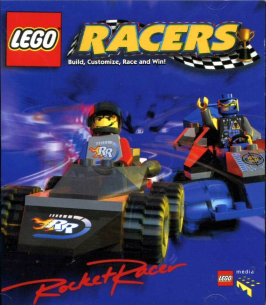
Lego Racers is a 1999 Lego-themed kart racing video game developed by High Voltage Software and published by Lego Media for Microsoft Windows, followed by console ports to Nintendo 64 and PlayStation. Set in the fictional "Legoland" universe, the single-player mode follows various minifigure characters competing in a racing competition created by a fictional racing champion called Rocket Racer.

NASCAR '98 is a racing simulator video game developed by Stormfront Studios, published by EA Sports, and released in 1997 for Sony PlayStation and Sega Saturn. This was the first game in the EA Sports NASCAR series.
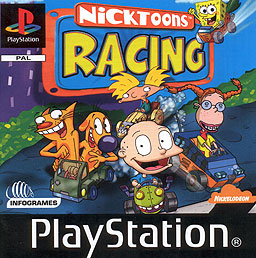
Nicktoons Racing is a racing video game developed by Software Creations and published by Infogrames for the PlayStation and Microsoft Windows. An abridged version developed by Pipe Dream and released for the Game Boy Color a year earlier, while Crawfish Interactive developed another abridged version for the Game Boy Advance, released in 2002. An arcade version developed by Chicago Gaming was released in 2003.

Formula One: Built to Win is a 1990 racing video game for the Nintendo Entertainment System developed by Winkysoft and published by SETA Corporation.
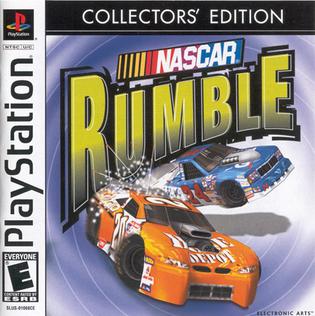
NASCAR Rumble is a racing video game created by Electronic Arts for the PlayStation. Players race through 18 different courses set in six different areas collecting powerups to aid them. The game is a departure from many NASCAR games, as it is an arcade racer featuring various tracks and Mario Kart-esque powerups. A non-NASCAR licensed sequel was made for the PlayStation 2, called Rumble Racing. There are drivers from the then Winston Cup Series and Craftsman Truck Series, as well as legend racers and bonus vehicles.

Toy Story Racer is a 2001 kart racing game developed by Traveller's Tales and Tiertex Design Studios and published by Activision. It was based on the Toy Story franchise, primarily the first film. The game was released in March 2001 for the Game Boy Color and PlayStation systems. The PlayStation version received "generally favorable reviews" according to Metacritic. In 2010, the PlayStation version was re-released on the PlayStation Store as a PS one Classic.

Antz Racing is a 2001 video game for the Game Boy Color, developed by RFX Interactive and published by Light and Shadow Production with Acclaim Entertainment co-publishing in North America and Electronic Arts co-publishing in Europe. The game is a kart racing game based on the 1998 film Antz.

Xtreme Wheels is a 2001 racing game developed by Spike and published by BAM! Entertainment for the Game Boy Color. Compared to Excitebike, the game is a BMX racing game in which the player competes with other riders to finish a motocross course.

Chase H.Q.: Secret Police is a vehicular combat game for the Game Boy Color developed by Dreams Co. Ltd and ITL Co. Ltd and published by Metro3D in 1999. The game is an installment in the Chase H.Q. series which began with a 1988 arcade video game by Taito.

Cubix: Robots for Everyone: Race 'n Robots is a 2001 racing game developed by Blitz Games and published by The 3DO Company, based on the Cubix: Robots for Everyone television series.

Armada F/X Racers is a 2000 video game for the Game Boy Color, developed by Metropolis Digital Inc. and published by Metro3D. The game is a futuristic-themed racing game based on the 1999 Dreamcast game Armada.

International Rally is a 1999 racing video game developed by Konami for the Game Boy Color. The game features rally races across 20 tracks set in international countries including France, Italy, Egypt and Japan. Upon release, International Rally received mixed to negative reviews, with critics praising the attempt to integrate racing simulation elements into a handheld game, but faulting its lack of variety, slow gameplay, and lacklustre visuals.





















